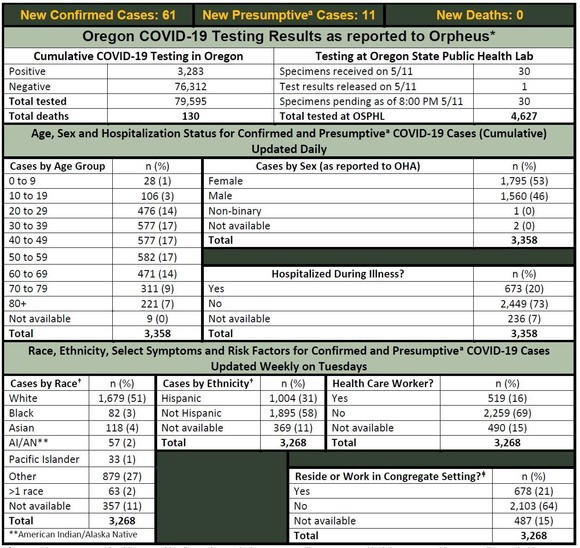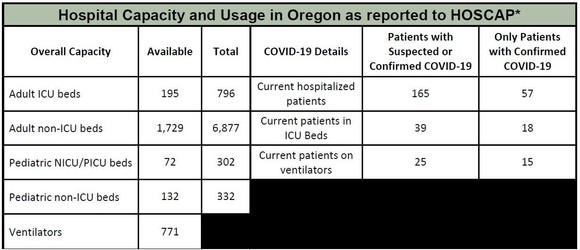|
Dear Friends and Neighbors,
The pandemic-caused economic recession gripping the nation will force state and local governments to rebalance their budgets because tax and fee revenues will be significantly less than anticipated before the pandemic. Things have changed dramatically in the span of a few months, and state budgets are no different.
Today, at the direction of Governor Brown, state agencies released budget reduction plans for the second year of the state’s two-year budget. Each agency has their proposed reduction list on their agency websites. Oregon Public Broadcasting has more information on those lists here. Legislators will need to make hard choices to rebalance the budget by September or earlier.
First, I want to emphasize that I will do all that I can to push the federal government to do more to help and tap reserves in order to prevent deep cuts to essential state programs and services. Budgets are not just numbers on a spreadsheet. Budgets are about people, our communities, and our collective well-being. This is the moment when funding for critical services like health care and education are needed more than ever.
I want to stress that none of the reduction lists that were published today are final. These are worst-case scenarios for our state. No cuts have been made. The Legislature, in collaboration with the Governor, will have to take action on the budget, but that won’t happen until after the state revenue forecast is released next week, on May 20. It’s highly likely that the state budget will be out of balance by two to three billion dollars.
At this point, we know that the coronavirus pandemic has caused historic unemployment levels and an economic shutdown across the nation and in Oregon, which will lead to a large budget shortfall. Prior to this pandemic, our state was one of the best prepared in the country to weather a recession because of our reserves, but this is unchartered territory.
So, difficult conversations about balancing the state budget are ahead of us. As those conversations move forward, I will fight to maintain our critical services and find creative ways to deal with our uncertain future.
There are now 32 of 36 Oregon counties that have applied for Phase 1 of reopening, which you can track and read here. Case-by-case decisions about whether those counties can begin gradually reopening starting Friday, May 15 will come later this week. All counties now remain under Stay Home, Save Lives.
In yesterday’s newsletter, I wrote about how retail stores that reopen in approved counties will look very different than they did before the coronavirus pandemic. Today, let’s look at restaurants and bars.
Restaurants and bars in counties that get approved for Phase 1 of reopening must do the following to allow for physical distancing:
-
Determine maximum occupancy to maintain physical distancing requirements and limit number of customers on premises accordingly.
-
Ensure tables are spaced at least 6 feet apart so that at least 6 feet between parties is maintained, including when customers approach or leave tables.
- Businesses will need to determine seating configuration to comply with these physical distancing requirements.
- Remove or restrict seating to facilitate the requirement of at least 6 feet of physical distance between people not in the same party.
- If booth seating is back-to-back, only use every other booth.
-
Limit parties to 10 people or fewer. Do not combine parties/guests at shared seating situations who have not chosen to congregate together. People in the same party seated at the same table do not have to be 6 feet apart.
- If a business is unable to maintain at least 6 feet of distance, except for brief interactions (for example, to deliver food to a table), it may operate only as pick up/to go service. This applies to both indoor and outdoor seating.
Restaurants and bars in counties that get approved for Phase 1 of reopening must also make the following accommodations for their employees:
-
Minimize employee bare-hand contact with food through use of utensils.
- Reinforce that meticulous hand hygiene (frequent and proper handwashing) is of utmost importance for all employees, including chefs, line cooks and waitstaff.
- Have employees wear gloves when performing cleaning, sanitizing, or disinfecting activities. If businesses choose to have employees use gloves, they must provide non-latex gloves and employees must prevent cross-contamination by replacing gloves after touching faces or changing tasks (e.g., food preparation versus taking out garbage).
- Require all employees to wear cloth, paper or disposable face coverings. Businesses must provide cloth, paper or disposable face covering for employees.
Additionally, restaurants and bars must:
- End all on-site consumption of food and drinks, including alcoholic beverages by 10 p.m.
-
Prohibit customer self-service operations, including buffets, salad bars, soda machines and growler refilling stations.
-
Disinfect customer-contact surfaces at tables between each customer/dining party including seats, tables, menus, condiment containers and all other touch points.
- Provide condiments, such as salt and pepper, ketchup, hot sauce and sugar, in single serve packets or from a single-service container. If that is not possible, condiment containers should not be pre-set on the table and must be disinfected between each customer or dining party.
-
Not pre-set tables with tableware (napkins, utensils, glassware).
-
Prohibit counter and bar seating unless the counter faces a window or wall and at least 6 feet of distance is maintained between parties. This applies to all facilities including bars, breweries and tasting rooms.
- Ensure customers/parties remain at least 6 feet apart when ordering. Signs should be posted as necessary to ensure that customers meet the requirements of this guidance. Mark designated spots on the floors must have designated spots where customers will wait in line.
- Frequently disinfect all common areas and touch points, including payment devices.
- Use menus that are single-use, cleanable between customers (laminated), online, or posted on a whiteboard or something similar in order to avoid multiple contact points.
- Prohibit use of karaoke machines, pool tables, and bowling.
Full details on OHA guidance are available here.
- Portland Parks and Recreation announced they won’t open public pools or recreation centers this summer due to coronavirus. The Oregonian has more information here.
- The Oregon Health Authority announced it has distributed 12 more Abbott ID NOW rapid test machines to health care providers in the following counties: Coos, Douglas, Grant, Klamath, Marion, Polk, Umatilla, Union, Wallowa and Wheeler. This testing capacity is distributed to priority areas that have no access to COVID-19 testing, a limited number of first responders, limited courier services for the state public health or commercial labs, and a high population of older adults and at-risk groups. More details from The Oregonian are available here.
- The Oregon Health Authority reported 61 more confirmed cases of coronavirus, bringing the statewide total to 3,283 confirmed cases. The agency also announced 11 new presumptive cases. There have been no new confirmed deaths since yesterday, meaning 130 Oregonians have died from confirmed cases of the virus. Additionally, the OHA published new recovery data that I've posted below. Nearly 45% of confirmed cases involving people who have survived are considered recovered, while 26.4% have not yet recovered and the recovery status of nearly 29% of people is still being assessed.



The latest daily update from the Oregon Health Authority includes an uptick in an already disproportionate percentage of confirmed coronavirus cases in the Latinx community. That figure has grown to 31%, despite the Latinx community making up about 13% of Oregon’s overall population. This disparity in Oregon was featured here late last week in The New York Times, as well as in recent articles by The Oregonian (here) and Oregon Public Broadcasting (here).
I continue to be frustrated and disturbed by this data. This virus does not discriminate. But, this pandemic does highlight many of the existing inequities that have been built into society for generations. I will keep pressing for better solutions so we can reverse this disproportionate impact.
Oregon is hiring hundreds of contact tracers as a key component of reopening our state economy. You can apply to be a contact tracer here and learn more about contact tracing with this video:

The federal government recently announced enrollment changes to help Medicare-eligible individuals make sure they have access to the critical health care coverage they need in the wake of the COVID-19 outbreak.
If you missed your chance to enroll in a Medicare health or drug plan because of COVID-19, you may qualify for a special enrollment period. Some people had difficulty filing their Part A or Part B enrollment application or enrollment election due to delays and problems of the Social Security field offices being closed. Relief is retroactive to March 17, 2020.
You can read the frequently asked questions for more details here. If you need help, call 1-800-722-4134.
To read past newsletters, you can go to this link. For up to date information, please check this link to the Oregon Health Authority where regular updates are posted: https://www.oregon.gov/oha/ERD/Pages/News-Releases.aspx
Please email me at Rep.TinaKotek@oregonlegislature.gov if you have specific concerns that have not been addressed by the OHA. Our office will do all we can to help and protect all Oregonians.
Thank you for reading! We will get through this together.

Best,

Tina Kotek
State Representative
House District 44
Speaker of the House
email: Rep.TinaKotek@oregonlegislature.gov I phone: 503-986-1200
address: 900 Court St NE, H-269, Salem, OR 97301
website: http://www.oregonlegislature.gov/kotek
|